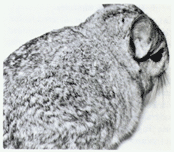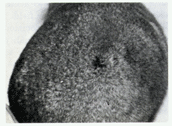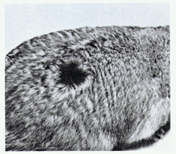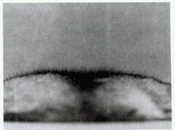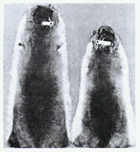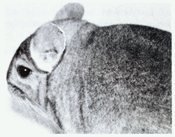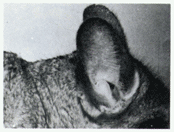Glossary of Terms
It was found at some of the classes for training Judges in the Empress Evaluation Program, that judges in different parts of the country used different explanatory terms. Or, some of them used the same terms, but with a different meaning. It was also found that one of the things a new judge had to learn, was those same terms. After the first few animals, the judge ran out of words. He kept saying the same things about every animal, over and over. From definitions in the dictionary; a study of articles in post issues of the magazine; conversations with experienced breeders and judges; and discussions at the above mentioned classes, the following Glossary of Terms should be used by judges with the approved definitions.
This is one of the first steps toward more uniform judging. I hope before the next judging season to have a group of slides illustrating most of these terms.
The following are descriptive terms that may be used by a judge or grader . . .
This is one of the first steps toward more uniform judging. I hope before the next judging season to have a group of slides illustrating most of these terms.
The following are descriptive terms that may be used by a judge or grader . . .
Compiled by Howard Clements
OVERALL COLOR
Blue ‑ The standard says that excellent color of veiling shall be a clear blue or black. When a
furrier calls a fur blue, he means clear; a sharp distinct shade of the desired color.
There is no blue pigment in standard chinchilla fur. What is wanted in the standard
chinchilla is black pigment with no red or yellow pigment. This, under certain light,
will give an illusion of blue. Veiling that is blue-black will tend to cause the bar to
be gray or blue‑gray where it blends into the edge of the bar. This will not cause the
bar to appear off‑color as is the case where black veiling that has a little red pigment
(brownish tint) blends into the top edge of the bar.
Black ‑ Sharp, clear black veiling, but without the bluish cast referred to above. Perhaps just
a hint of red or yellow pigment in the fur to give a slight drop in clarity, but not the
appearance of off‑color.
Bright ‑ Lustrous, sharp color reflecting light.
Clear - The desired color with no off color of any type.
Shaded ‑ Just a little dull; not quite as sharp or brilliant as desired.
Muddy ‑ Dull, cloudy, fur without luster or sheen.
Dull ‑ Lacks luster; old fur; past prime; no sheen.
Washed Out ‑ Lack of good veiling and/or a muddy bar kills the luster and the
beauty of the fur.
Mousy ‑ Again, a dull flat gray fur with no sheen or luster.
No Character ‑ Similar to mousy and dull; not beautiful.
Cast or Casty ‑ Very slightly offcolor; the next step below shaded; muddy or dull.
Off‑Color ‑ The fur has some degree of red or yellow pigment either in the bar or veiling or
both Showing up as a brown or yellow tinge. Usually expressed as slightly
off‑color or badly off‑color.
Density
The density of fur refers to the thickness of fur. Both the spacing of the fur follicles and the number of strands of fur per follicle. The number of fur follicles per unit area of skin is fixed at birth and cannot be changed by diet or environment. The number of strands of fur per follicle can be changed by diet, temperature, light or other environmental factors as well as the genetic inheritance of the animal. Density of the fur may be checked by LIGHTLY blowing into the fur. A light puff of air on the shoulder or hip of the animal should be enough to determine the density. If the animal is thinly furred on the neck, it will also be thin on the shoulder. Most of them are more heavily furred on the rump so it is not necessary to check there. To repeat, it
is neither necessary nor desirable to blow hard or to blow all over the animal; this will only create a significant pattern disturbance. Simply blow just enough to separate the fur in order to determine whether it is thick or not. It IS necessary to blow on some of the animals, however. I know, some people say that it is not necessary to blow into the fur to determine density. I also know some judges have made a fool of themselves by saying an animal was thinly furred, or vice‑versa, when the opposite was true. So, it is not fair to the animal or the owner to fail to blow lightly into the fur WHEN NECESSARY.
is neither necessary nor desirable to blow hard or to blow all over the animal; this will only create a significant pattern disturbance. Simply blow just enough to separate the fur in order to determine whether it is thick or not. It IS necessary to blow on some of the animals, however. I know, some people say that it is not necessary to blow into the fur to determine density. I also know some judges have made a fool of themselves by saying an animal was thinly furred, or vice‑versa, when the opposite was true. So, it is not fair to the animal or the owner to fail to blow lightly into the fur WHEN NECESSARY.
Very Dense ‑Close spacing of the follicles and many strands of fur in each follicle, making it
difficult to see the skin on any part of the animal
Dense ‑ A good volume of fur with good resilience. In grading, we teach that the patch of skin
you see when lightly puffing into the fur should be no larger than a grain of wheat or
rice. Density should be checked in the area where the fur is the thinnest, usually on
the neck, shoulder, hip or sides.
Plushy ‑Indicating a great volume of far, this would be a combination of density, fur length
and resilience.
Fur Strength ‑ Really a separate item but a judge may comment on it in relation to density.
Snap ‑Same as above, pertains more to resilience but may be a comment on density.
Open ‑ Very thin fur that lies open. Often used as "open hips."
Compact ‑Usually used to describe a short‑furred, dense animal.
Thin Fur ‑ Few strands of fur per follicle. The opposite of dense. Lack of sufficient fur to
make a satisfactory pelt.
Fur Patterns
Fur Pattern ‑ The flow of fur over the animal or pelt.
Silky ‑ The dictionary says "lustrous smooth;" where it is used describing pattern, it should
mean a soft, smooth, even flow of fur.
Smooth ‑ An even flow of fur with no disturbance.
Velvety ‑ An even flow of fur that has the appearance of velvet. Uniform, even fur length.
Even ‑ The fur appears to all be of the same length, prime, smooth, no disturbance.
Break In Pattern ‑ Slight break in the smooth flow of fur; small spot of fur missing;
anything that disturbs the smooth, even flow of fur.
Rippled ‑ Slight ruffling of the surface; small waves on the fur.
Choppy ‑ Larger, uneven ripples or short, uneven small waves.
Wavy ‑ The fur usually waves from side to side rather than up and down.
Swirly ‑ Badly waved, almost curled.
Cowlick ‑A swirl or twist in the fur making a complete circle.
Marcelled – Regular, small, continuous waves.
Curly ‑ Small, tight swirls.
Rough ‑ Fur badly disturbed in any manner.
New Fur ‑ An unprime condition with new fur coming in but not fully grown out.
Singed ‑ The fine tips of the fur having the appearance of having been lightly burned with a
hot iron. Usually seen on old fur, but can be caused by a coarse, sharp dust bath or
friction on a surface.
Priming Line ‑ A point or line on the fur where new fur, coming in, is just reaching the
surface. Causing a slight wave or break in the smooth surface of the fur.
Split Grotzen ‑ The grotzen is the darker streak of veiling down the back of the chinchilla.
Most animals with hair or fur on their back have this darker streak. A split
grotzen is a parting of the fur that runs down the backer the animal.
Chewed or Fur Chewed ‑ A spot or area where the veiling and bar is chewed off so the
underfur is visible. Woolly‑Matted fur, usually slightly curled,
resembling wool.
Cottony ‑ Similar to woolly, matted without a definite flow pattern.
Matted ‑ Fur forms a tangled mass. Often caused because the old dead fur has not shed out
and is tangled with the new fur when it grows in.
Fur Balls ‑ Small matted areas, often only an eighth inch or less in size.
Mottled ‑ Spotted or blotched in color because of fur disturbance. The bar showing through
the veiling in spots.
Plymouth Rock ‑ A mottled appearance in stripes across the back. As the appearance of the
coloring on the feathers of a Plymouth Rock chicken.
Salt and Pepper ‑ A mottled appearance with very small spots.
Out of Prime ‑ The chinchilla is in process of growing a new coat of far. The new fur coming
in causes rough spots on the surface of the fur and detracts from the
appearance of the animal.
Not In Show Condition ‑ To be in show condition, a chinchilla should be as nearly prime
and smooth as possible. Any of the descriptive terms used
under the descriptions of fur pattern would cause the animal to
be not in show condition.
Texture
In theory texture means the fineness or coarseness of the fur. In practice it means the overall appearance of softness or fineness of the fur. Many of the same terms are used as in the description of pattern. Some confusion exists as for many years the term texture originally meant what we now mean by both texture and pattern. Now texture is used to mean only the appearance of softness and pattern, the arrangement of the fur.
Silky ‑ Very fine closely set hairs; smooth, soft appearance.
Fine ‑ Very thin strands of fur. Not quite as soft appearing as silky.
Coarse ‑ Opposite of fine, the fur strands appear to be larger in diameter.
Past Prime ‑ The fur has lost its luster. It appears dull and lacks the silk appearance of fine
fur.
Singed, Woolly, Cottony ‑ Mean the same as applied to fur pattern.
Veiling Coverage
The veiling of a chinchilla is the darker tips on each strand of fur. The pattern of color formed by the distribution of the density of the veiling tips and the amount of this darker color is termed the veiling coverage or veiling pattern.
Dense ‑ Heavily veiled or thickly covered with veiling.
Uniform ‑Evenly covered with veiling.
Even Flow ‑ Same meaning. Uniform coverage.
Washed Out ‑ Lack of veiling; insufficient veiling coverage.
Open Hips ‑ Lack of veiling over the hips.
Weak on Neck ‑ Lack of veiling over the neck. Usually accompanied by lack of veiling on
the shoulders.
Wrap Around ‑ The way the veiling pattern extends down the sides of the animal.
Grotzen ‑ The darker stripe down the back of the animal.
Fur Strength
Snap ‑ To make a quick return to the former position after the fur has been disturbed.
Resilience ‑ The ability to return to the former position; rebound.
Plushy ‑ Fur with good density and volume that has resilience.
Flat ‑ Lies flat on the body.
Weak ‑ Usually too fine fur that lacks strength and resiliency.
Crew Cut ‑ Fur that stands up on the animal as opposed to fur that lies down.
Strong - Not extremely fine fur, but fur with good resiliency and snap.
Bar Uniformity
No Bar ‑ Bar is very gray and/or very narrow to the point where it is not readily apparent.
Narrow Bar ‑ Bar that is narrower than that specified in the standard.
Wide Bar ‑ Bar that is wider than the standard, usually on the hips.
Muddy ‑ Bar that is gray, dull, not distinct.
Gray ‑ Bar with enough black or gray pigment that it is not bright and distinct.
Blended ‑ Not sharply defined. Most young animals have a bar that is gray or blended as the
first three coats of fur are not all of exactly the same length so the edges of the
bar tend to blend with the veiling and underfur.
Mingled with Top Fur ‑ Badly blended so as to be almost invisible.
Fur Length and Volume
Fur Length ‑ The standard says "the fur should be approximately the same length over the
neck, back, rump, hips and sides. It should be between 3 /4 and 11/4 inches
long." Short Fur‑Would be fur definitely shorter than specified by the
standard.
Crew Cut ‑ Fur that grows perpendicularly to the skin.
Uneven Length ‑Could be used to describe unprime fur with priming lines, or fur too short
on the neck or back, or too long on hips or rump.
Too Long ‑ Fur longer than the standard, usually on hips or rump. Lies Open ‑ Very thin fur
with no resilience; usually too long.
Plushy ‑ Good volume with good density and resilience.
Good Quality ‑ Quality to a furrier means everything except color. Good quality would
mean good density, volume, resilience, texture, pattern, etc.
King Hair
Too Long ‑ The king hair should stand 1/8 to 1/4 inch above the fur; it should not be so long
as to make the animal appear shaggy. However, the king hair on the pelt usually
does not stand up, it lies down, so what appears to be long king hair on the live
animal may not detract from the pelt.
Not Enough ‑ There should be enough king hair to be readily apparent all over the animal.
Too Much ‑ I have heard judges comment on too much king hair, but I question if there
could be too much. I think they probably meant too long.
Coarse ‑ The king hair normally is much coarser than the fur. I don't know what the
diameter of the hair is supposed to be or how you would determine if it were
too coarse.
Glossy ‑ Lustrous, shiny.
Size
The size of area of the pelt is very important, as a large pelt will bring much more than a small pelt. In judging the animal the estimated of the pelt should be kept in mind. A fat animal will not always have a larger pelt than one that is not fat.
The average adult chinchilla will weigh approximately 16‑20 ounces and produce a pelt approximately 3‑1/2 ‑ 4‑1/2 inches wide and 12‑15 inches long. The terms extra large, large, medium, average and small are self‑explanatory.
The average adult chinchilla will weigh approximately 16‑20 ounces and produce a pelt approximately 3‑1/2 ‑ 4‑1/2 inches wide and 12‑15 inches long. The terms extra large, large, medium, average and small are self‑explanatory.
Long Body ‑ A Lanigera or large Costina type animal.
Baby ‑ Not full grown, an explanation of size.
Conformation
Costina ‑ A small chinchilla supposedly originally from lower altitudes of Chile with a longer
body, narrow shoulders, a dip in the neck and short fur.
Lanigera ‑ A larger animal, average size, said to come from higher altitudes of Chile and
Peru.
Brevicaudata ‑ (Spanish for short tail) A large blocky chinchilla with longer fur and very
small ears. Almost all of our present chinchillas are crosses of these various
types. The type usually preferred by the judges is a large Lanigera type
with Brevicaudata conformation.
Round Body ‑ Animal that appears almost round when viewed from above.
Oval ‑ A little longer body; oval when viewed from above.
Long ‑ Body longer and narrower than the oval body.
Narrow ‑ A long narrow body, wider on the hips than through the shoulders.
Compact Body ‑ Round or oval, short and blocky.
Blocky ‑ A short, round body‑wide through the neck and shoulders.
Neck
The neck is important as that is the weakest point on most of our pelts. Usually the fur is thinner, may be shorter and lacks veiling on the neck.
Full Neck ‑ A chinchilla with a full neck, when viewed from the side would appear to have
almost a straight line along the top of the fur from the head over the neck to
the back.
Roached ‑ The fur extending higher on the neck than on the head and shoulders.
Medium Full ‑ The fur in the neck area dipping very slightly.
Dip in the Neck ‑ The fur shorter in the neck area than on the body so there appears to be
a pronounced dip in that area when viewed from the side.
Bull Neck ‑ A large full‑furred neck with a roach so the fur extends above the head and body
of the animal.
Short Neck ‑ Self‑explanatory; a short, round blocky animal.
empress chinchilla‑‑July, 1973

